-

新人教版高中英语必修3Unit 1 Festivals and Celebrations-Reading and Thinking教学设计
The topic of this part is “Discover the reasons for festivals and celebrations.The Listening & Speaking & Talking part aims at talking about the experiences and feelings or emotions about the festivals and celebrations. This section aims at detecting the reason why the people celebrate the festivals, the time, the places, the types and the way of celebrations. It also explains why some traditions in the old celebrations are disappearing, like the firecrackers in the big cities and some new things are appearing like the prosperity of business or commerce. 1. Students can talk about what festivals they know and the reasons and the way of celebrating them.2. Students should learn the reading skills such as the headline and get the topic sentences, the structures of articles.3. Students can understand the past, the present situation of some festival around the world and why there are some changes about them. 4. Students can have the international awareness about the festivals.1. Students should learn the reading skills such as the headline and get the topic sentences, the structures of articles.2. Students can understand the past, the present situation of some festival around the world and why there are some changes about them.Step 1 Lead in---Small talkWhat festival do you like best ? Why ?I like the Spring Festivals because I can set off the fireworks, receive the lucky money and enjoy the Gala with my families.Step 2 Before reading---Pair workWhy do people celebrate different festivals ?The Spring Festivals is to celebrate the end of winter and the coming of spring and new life.The Mid-autumn Day is to celebrate the harvest and admire the moon.

新人教版高中英语必修3Unit 1 Festivals and Celebrations-Listening &Speaking&Talking教学设计
The theme of this section is “Talk about festival activities and festival experiences”.Festival and holiday is a relaxing and interesting topic for students. This part talks about the topic from the daily life of students’. In the part A ---Listening and Speaking, there are three conversations among different speakers from three countries(Japan, Rio and China), where the speakers are participating in or going to participate in the festivals and celebrations. So listening for the relationship among them is a fundamental task. Actually, with the globalization and more international communication, it is normal for Chinese or foreigners to witness different festivals and celebrations in or out of China. In the Conversation 1, a foreign reporter is interviewing a Japanese young girl who just had participated in the ceremony of the Coming-of-Age Day on the street and asking her feeling about the ceremony and the afterwards activities. Conversation 2, Chinese girl Li Mei is witnessing the Rio Carnival for the first time, and her friend Carla gives her some advice on the costumes which enables her to match with the carnival to have a good time. Conversation 3, a Chinese guide is showing a group of foreign visitors around the Lantern Festival and introducing the customs of the festival to them. The three conversations have a strong vitality and insert the festival and cultural elements from different countries. So perceiving the festivals and cultures from different countries is the second task. At the same time, the scripts also insert the targeted grammar --- v-ing as attributive and predicative, which students can perceive and experience in a real context and make a road for the further study. That is the third task. In the Part B--- Listening and Talking, the theme is “Talk about festival experience”, which is the common topic in our daily conversations. During the conversation, Song Lin, a Chinese student, asked Canadian friend Max about how to spend Christmas. In the conversation, Song Lin talked about experience and the feelings during the Chinese Spring Festival, during which there are not only some enjoyable things but some unpleasant things. After the listening, perhaps students find there are some similarities between Christmas and the Chinese Spring Festival as there are some differences in the origins and celebrations. For example, people always visit friends and relatives, decorate their houses, have a big dinner together, chat and give presents to each other.

新人教版高中英语选修2Unit 1 Science and Scientists-Learning about Language教学设计
Step 7: complete the discourse according to the grammar rules.Cholera used to be one of the most 1.__________ (fear) diseases in the world. In the early 19th century, _2_________ an outbreak of cholera hit Europe, millions of people died. But neither its cause, 3__________ its cure was understood. A British doctor, John Snow, wanted to solve the problem and he knew that cholera would not be controlled _4_________ its cause was found. In general, there were two contradictory theories 5 __________ explained how cholera spread. The first suggested that bad air caused the disease. The second was that cholera was caused by an _6_________(infect) from germs in food or water. John Snow thought that the second theory was correct but he needed proof. So when another outbreak of cholera hit London in 1854, he began to investigate. Later, with all the evidence he _7_________ (gather), John Snow was able to announce that the pump water carried cholera germs. Therefore, he had the handle of the pump _8_________ (remove) so that it couldn't be used. Through his intervention,the disease was stopped in its tracks. What is more, John Snow found that some companies sold water from the River Thames that __9__________________ (pollute) by raw waste. The people who drank this water were much more likely _10_________ (get) cholera than those who drank pure or boiled water. Through John Snow's efforts, the _11_________ (threaten) of cholera around the world saw a substantial increase. Keys: 1.feared 2.when 3. nor 4.unless 5.that/which 6.infection 7.had gathered 8.removed 9.was polluted 10.to get 11. threat

新人教版高中英语选修2Unit 1 Science and Scientists-Reading and thinking教学设计
Step 5: After learning the text, discuss with your peers about the following questions:1.John Snow believed Idea 2 was right. How did he finally prove it?2. Do you think John Snow would have solved this problem without the map?3. Cholera is a 19th century disease. What disease do you think is similar to cholera today?SARS and Covid-19 because they are both deadly and fatally infectious, have an unknown cause and need serious public health care to solve them urgently.keys:1. John Snow finally proved his idea because he found an outbreak that was clearly related to cholera, collected information and was able to tie cases outside the area to the polluted water.2. No. The map helped John Snow organize his ideas. He was able to identify those households that had had many deaths and check their water-drinking habits. He identified those houses that had had no deaths and surveyed their drinking habits. The evidence clearly pointed to the polluted water being the cause.3. SARS and Covid-19 because they are both deadly and fatally infectious, have an unknown cause and need serious public health care to solve them urgently.Step 6: Consolidate what you have learned by filling in the blanks:John Snow was a well-known _1___ in London in the _2__ century. He wanted to find the _3_____ of cholera in order to help people ___4_____ it. In 1854 when a cholera __5__ London, he began to gather information. He ___6__ on a map ___7___ all the dead people had lived and he found that many people who had ___8____ (drink) the dirty water from the __9____ died. So he decided that the polluted water ___10____ cholera. He suggested that the ___11__ of all water supplies should be _12______ and new methods of dealing with ____13___ water be found. Finally, “King Cholera” was __14_____.Keys: 1. doctor 2. 19th 3.cause 4.infected with 5.hit 6.marked 7.where 8.drunk 9.pump 10.carried 11.source 12.examined 13.polluted 14.defeatedHomework: Retell the text after class and preview its language points

新人教版高中英语选修2Unit 1 Science and Scientists-Using langauge教学设计
This happens because the dish soap molecules have a strong negative charge, and the milk molecules have a strong positive charge. Like magnets, these molecules are attracted to each other, and so they appear to move around on the plate, taking the food coloring with them, making it look like the colors are quickly moving to escape from the soap.Listening text:? Judy: Oh, I'm so sorry that you were ill and couldn't come with us on our field trip. How are you feeling now? Better?? Bill: Much better, thanks. But how was it?? Judy: Wonderful! I especially liked an area of the museum called Light Games.it was really cool. They had a hall of mirrors where I could see myself reflected thousands of times!? Bill: A hall of mirrors can be a lot of fun. What else did they have?? Judy: Well, they had an experiment where we looked at a blue screen for a while, and then suddenly we could see tiny bright lights moving around on it. You'll never guess what those bright lights were!? Bill: Come on, tell me!? Judy: They were our own blood cells. For some reason, our eyes play tricks on us when we look at a blue screen, and we can see our own blood cells moving around like little lights! But there was another thing I liked better. I stood in front of a white light, and it cast different shadows of me in every color of the rainbow!? Bill: Oh, I wish I had been there. Tell me more!? Judy: Well, they had another area for sound. They had a giant piano keyboard that you could use your feet to play. But then, instead of playing the sounds of a piano, it played the voices of classical singers! Then they had a giant dish, and when you spoke into it, it reflected the sound back and made it louder. You could use it to speak in a whisper to someone 17 meters away.? Bill: It all sounds so cool. I wish I could have gone with you? Judy: I know, but we can go together this weekend. I'd love to go there again!? Bill: That sounds like a great idea!

新人教版高中英语选修2Unit 1 Science and Scientists-Discovering useful structures教学设计
The grammatical structure of this unit is predicative clause. Like object clause and subject clause, predicative clause is one of Nominal Clauses. The leading words of predicative clauses are that, what, how, what, where, as if, because, etc.The design of teaching activities aims to guide students to perceive the structural features of predicative clauses and think about their ideographic functions. Beyond that, students should be guided to use this grammar in the context apporpriately and flexibly.1. Enable the Ss to master the usage of the predicative clauses in this unit.2. Enable the Ss to use the predicative patterns flexibly.3. Train the Ss to apply some skills by doing the relevant exercises.1.Guide students to perceive the structural features of predicative clauses and think about their ideographic functions.2.Strengthen students' ability of using predicative clauses in context, but also cultivate their ability of text analysis and logical reasoning competence.Step1: Underline all the examples in the reading passage, where noun clauses are used as the predicative. Then state their meaning and functions.1) One theory was that bad air caused the disease.2) Another theory was that cholera was caused by an infection from germs in food or water.3) The truth was that the water from the Broad Street had been infected by waste.Sum up the rules of grammar:1. 以上黑体部分在句中作表语。2. 句1、2、3中的that在从句中不作成分,只起连接作用。 Step2: Review the basic components of predicative clauses1.Definition
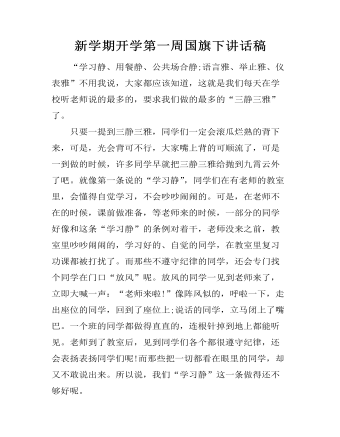
新学期开学第一周国旗下讲话稿
“学习静、用餐静、公共场合静;语言雅、举止雅、仪表雅”不用我说,大家都应该知道,这就是我们每天在学校听老师说的最多的,要求我们做的最多的“三静三雅”了。只要一提到三静三雅,同学们一定会滚瓜烂熟的背下来,可是,光会背可不行,大家嘴上背的可顺流了,可是一到做的时候,许多同学早就把三静三雅给抛到九霄云外了吧。就像第一条说的“学习静”,同学们在有老师的教室里,会懂得自觉学习,不会吵吵闹闹的。可是,在老师不在的时候,课前做准备,等老师来的时候,一部分的同学好像和这条“学习静”的条例对着干,老师没来之前,教室里吵吵闹闹的,学习好的、自觉的同学,在教室里复习功课都被打扰了。而那些不遵守纪律的同学,还会专门找个同学在门口“放风”呢。放风的同学一见到老师来了,立即大喊一声:“老师来啦!”像阵风似的,呼啦一下,走出座位的同学,回到了座位上;说话的同学,立马闭上了嘴巴。一个班的同学都做得直直的,连根针掉到地上都能听见。老师到了教室后,见到同学们各个都很遵守纪律,还会表扬表扬同学们呢!而那些把一切都看在眼里的同学,却又不敢说出来。所以说,我们“学习静”这一条做得还不够好呢。
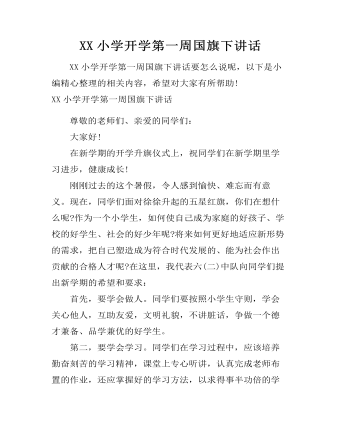
XX小学开学第一周国旗下讲话
XX小学开学第一周国旗下讲话要怎么说呢,以下是小编精心整理的相关内容,希望对大家有所帮助!XX小学开学第一周国旗下讲话 尊敬的老师们、亲爱的同学们:大家好!在新学期的开学升旗仪式上,祝同学们在新学期里学习进步,健康成长!刚刚过去的这个暑假,令人感到愉快、难忘而有意义。现在,同学们面对徐徐升起的五星红旗,你们在想什么呢?作为一个小学生,如何使自己成为家庭的好孩子、学校的好学生、社会的好少年呢?将来如何更好地适应新形势的需求,把自己塑造成为符合时代发展的、能为社会作出贡献的合格人才呢?在这里,我代表六(二)中队向同学们提出新学期的希望和要求:首先,要学会做人。同学们要按照小学生守则,学会关心他人,互助友爱,文明礼貌,不讲脏话,争做一个德才兼备、品学兼优的好学生。第二,要学会学习。同学们在学习过程中,应该培养勤奋刻苦的学习精神,课堂上专心听讲,认真完成老师布置的作业,还应掌握好的学习方法,以求得事半功倍的学习效果。
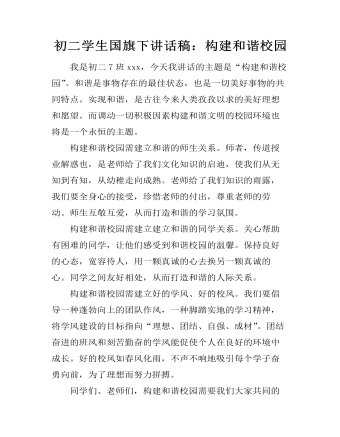
初二学生国旗下讲话稿:构建和谐校园
我是初二7班xxx,今天我讲话的主题是“构建和谐校园”。和谐是事物存在的最佳状态,也是一切美好事物的共同特点。实现和谐,是古往今来人类孜孜以求的美好理想和愿望。而调动一切积极因素构建和谐文明的校园环境也将是一个永恒的主题。构建和谐校园需建立和谐的师生关系。师者,传道授业解惑也,是老师给了我们文化知识的启迪,使我们从无知到有知,从幼稚走向成熟。老师给了我们知识的雨露,我们要全身心的接受,珍惜老师的付出,尊重老师的劳动。师生互敬互爱,从而打造和谐的学习氛围。构建和谐校园需建立建立和谐的同学关系。关心帮助有困难的同学,让他们感受到和谐校园的温馨。
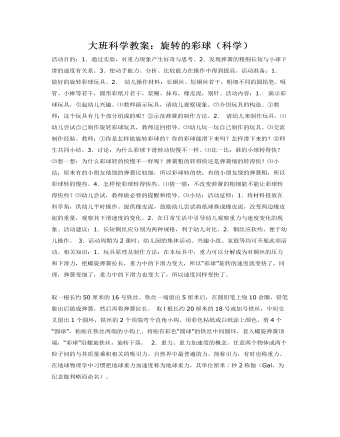
大班科学教案:旋转的彩球(科学)
2.幼儿操作材料:长铜丝、短铜丝若干,粗细不同的圆铅笔、吸管、小棒等若干,圆形彩纸片若干,浆糊、抹布,橡皮泥,别针。活动内容:1.演示彩球玩具,引起幼儿兴趣。⑴教师演示玩具,请幼儿观察现象。⑵介绍玩具的构造。①教师:这个玩具有几个部分组成的呢?②示范弹簧的制作方法。2.请幼儿来制作玩具。⑴幼儿尝试自己制作旋转彩球玩具,教师巡回指导。⑵幼儿玩一玩自己制作的玩具。⑶交流制作经验。教师:①你是怎样做旋转彩球的?你的彩球能滑下来吗?怎样滑下来的?②师生共同小结。3.讨论:为什么彩球下滑转动快慢不一样。⑴比一比:谁的小球转得快?⑵想一想:为什么彩球转的快慢不一样呢?弹簧粗的转得快还是弹簧细的转得快?⑶小结:原来有的小朋友他绕的弹簧比较细,所以彩球转的快;有的小朋友绕的弹簧粗,所以彩球转的慢些。4.怎样使彩球转得快些。⑴猜一猜:不改变弹簧的粗细能不能让彩球转得快些?⑵幼儿尝试,教师做必要的提醒和指导。⑶小结:活动延伸:1.将材料投放在科学角,供幼儿平时操作。提供橡皮泥,鼓励幼儿尝试将纸球换成橡皮泥,改变两边橡皮泥的重量,观察其下滑速度的变化。2.在日常生活中引导幼儿观察重力与速度变化的现象。活动建议:1.长短铜丝应分别为两种规格,利于幼儿对比。
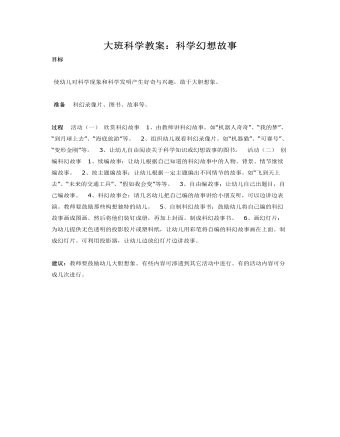
大班科学教案:科学幻想故事
过程 活动(一)欣赏科幻故事 1、由教师讲科幻故事。如“机器人奇奇”、“我的梦”、“到月球上去”、“海底旅游”等。 2、组织幼儿观看科幻录像片。如“机器猫”、“可赛号”、“变形金刚”等。 3、让幼儿自由阅读关于科学知识或幻想故事的图书。 活动(二)创编科幻故事 1、续编故事:让幼儿根据自己知道的科幻故事中的人物、背景、情节继续编故事。
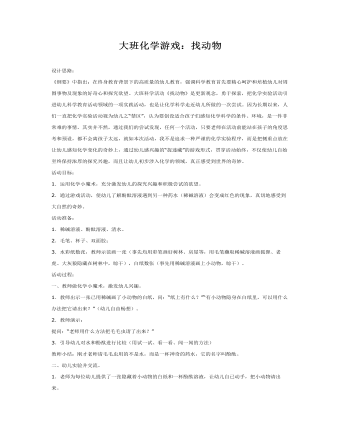
大班科学教案:化学游戏:找动物
活动目标: 1.运用化学小魔术,充分激发幼儿的探究兴趣和积极尝试的欲望。 2.通过游戏活动,使幼儿了解酚酞溶液遇到另一种药水(稀碱溶液)会变成红色的现象,真切地感受到大自然的奇妙。 活动准备: 1.稀碱溶液、酚酞溶液、清水。 2.毛笔、杯子、双面胶; 3.水彩纸数张,教师示范画一张(事先均用彩笔画好树林、房屋等,用毛笔蘸取稀碱溶液画狐狸、老虎、大灰狼隐藏在树林中,晾干),白纸数张(事先用稀碱溶液画上小动物,晾干)。 活动过程: 一、教师做化学小魔术,激发幼儿兴趣。 1.教师出示一张已用稀碱画了小动物的白纸,问:“纸上有什么?”“有小动物隐身在白纸里,可以用什么办法把它请出来?”(幼儿自由畅想)。 2.教师演示: 提问:“老师用什么方法把毛毛虫请了出来?” 3.引导幼儿对水和酚酞进行比较(用试一试、看一看、闻一闻的方法) 教师小结:刚才老师请毛毛虫用的不是水,而是一杯神奇的药水,它的名字叫酚酞。
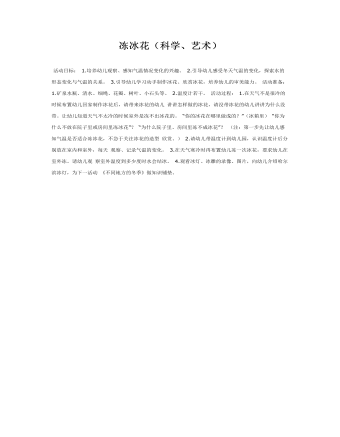
大班科学教案:冻冰花(科学、艺术)
2.引导幼儿感受冬天气温的变化,探索水的形态变化与气温的关系。 3.引导幼儿学习动手制作冰花、欣赏冰花,培养幼儿的审美能力。活动准备: 1.矿泉水瓶、清水、细绳、花瓣、树叶、小石头等。 2.温度计若干。活动过程: 1.在天气不是很冷的时候布置幼儿回家制作冰花后,请带来冰花的幼儿讲讲怎样做的冰花,请没带冰花的幼儿讲讲为什么没带。让幼儿知道天气不太冷的时候室外是冻不出冰花的。 “你的冰花在哪里做成的?”(冰箱里) “你为什么不放在院子里或房间里冻冰花”? “为什么院子里、房间里冻不成冰花”?

中小学校章程建设及规章制度清理工作报告
一、学校章程制度建设的重要意义 学校章程建设是推进依法治教、依法办学的需要,是构建现代学校管理体制的需要,是推动学校文化建设的需要,是依法推进教育改革和发展的需要,也是依法治校的一项基础性工程。各学校要通过学校章程编制建设,结合新的教育管理体制,认真研究学校制度建设情况,全面、认真地清理、修订已建立的学校管理制度,进一步完善相关工作规范和制度要求,在研究的基础上,通过全面的整理和整合,形成一套系统的、适应学校管理和发展的中小学常规管理制度。
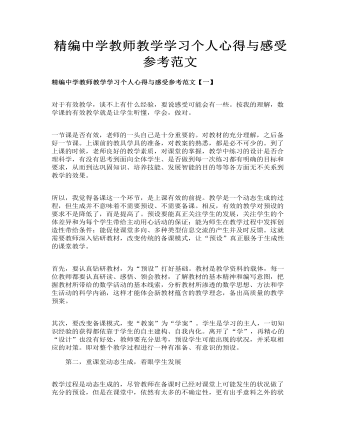
精编中学教师教学学习个人心得与感受参考范文
首先,要认真钻研教材,为“预设”打好基础。教材是教学资料的载体,每一位教师都要认真研读、感悟、领会教材,了解教材的基本精神和编写意图,把握教材所带给的数学活动的基本线索,分析教材所渗透的数学思想、方法和学生活动的科学内涵,这样才能体会新教材蕴含的教学理念,备出高质量的教学预案。 其次,要改变备课模式,变“教案”为“学案”。学生是学习的主人,一切知识经验的获得都依靠于学生的自主建构、自我内化。离开了“学”,再精心的“设计”也没有好处,教师要充分思考,预设学生可能出现的状况,并采取相应的对策。即对整个教学过程进行一种有准备、有意识的预设。
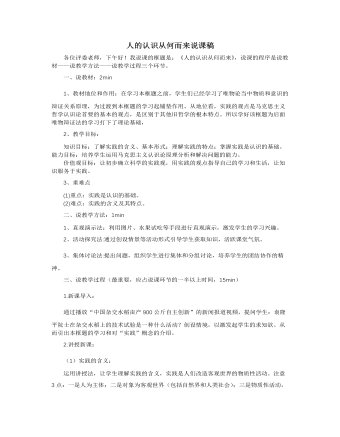
人教版高中政治必修4人的认识从何而来说课稿(一)
展示学习过的物理学内容:伽利略的“比萨斜塔”实验,证明了:两个铁球同时落地。得出结论:实践是检验认识正确与否的唯一标准。(因为这点理解起来有点难,所一教师要适当的讲解)A、一种认识是否是真理不能由这一认识本身回答B、客观事物自身也不能回答认识是否正确地反映了它C、实践是联系主观与客观的桥梁。人们把认识和实践的结果对照,相符合,认识就正确。○4实践是认识的目的和归宿:走进社会:(课本P46归国博士案例)从这个故事中我们可以得到什么启示?得出结论:实践是认识的归宿和目的。启发学生学以致用,eg:纪中的学生研究地沟油简易检测方法(灵活利用身边的教学资源)。【板书设计】实践是认识的基础(板书)投影:逐步展示本课知识结构图。学生通过回忆,让学生有直观的认识,学习内容一目了然。1.实践是认识的来源。2.实践是认识发展的动力。3.实践是检验认识的真理性的唯一标准。
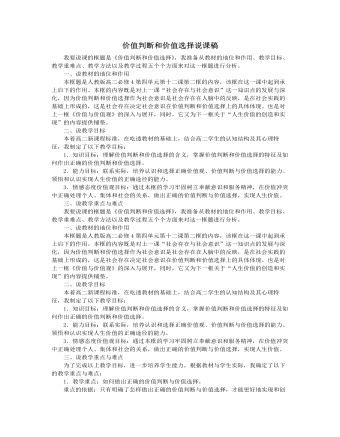
人教版高中政治必修4价值判断和价值选择说课稿(一)
2.讲授新课:(约35分钟)结合教材内容重难点和学生实际,在讲课过程中,我对教材内容的顺序进行了重组,把教材内容由原来的两大部分划分为三大部分(第一,价值判断和价值选择的含义和关系;第二,价值判断和价值选择的特征;第三,做出正确的价值判断和价值选择的标准)。这一调整更符合学生的认知结构,便于从整体上把握课本内容。在讲授过程中,我充分利用课本素材——探究活动为课堂教学服务,此外,利用学生的生活与体验,挖掘实例,如结婚要礼由以前的旧三件到现如今的转变,引导学生理解价值判断和价值选择的社会历史性特征,以以《观祈雨》、以医生、艺术家、老学究对于《断臂的维纳斯》这个雕塑的不同见解、以新鲜实例韩国沉船事件和范跑跑为例启发学生价值判断和价值选择具有主体差异性特征以此突破难点,最后通过设疑、对比、追问正确的价值判断和价值选择的标准来深化主题,突出重点。3.课堂小结:(约2分钟)强化认识
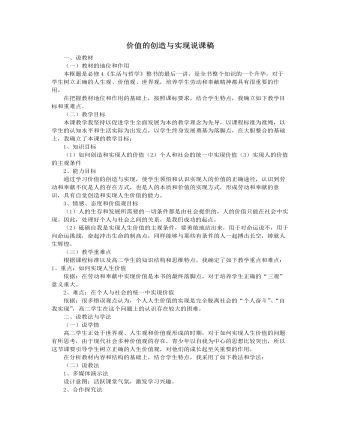
人教版高中政治必修4价值的创造与实现说课稿(一)
(六)巩固练习:习题见教学设计(七)布置作业:适量的同步练习题设计意图:反馈矫正,以便于进行教后反思。四、说教学反思新课程理念呼唤改变学生的学习方式,建立旨在调动和发挥学生主体作用的自主、合作、探究的学习方式。鼓励学生结合实际大胆对一些问题进行探究,在活动中体验和领悟,从而构建新的知识。通过探究、思辨、实践等方式,引导学生生成核心哲学观点,展示学生生活智慧,培养科学思维习惯,提升学生思维能力,形成情感、态度与价值观。本课例在设计时围绕本框的三个知识点:“在劳动和奉献中创造价值”、“在个人与社会的统一中实现价值”和“在砥砺自我中走向成功”,按照“情境导入——激发情意——自主学习,合作探究。”模式展开教学。在这样的教学中,我们收获了新课改教学经验,但是也存在着不足,日后还需继续加以改进。
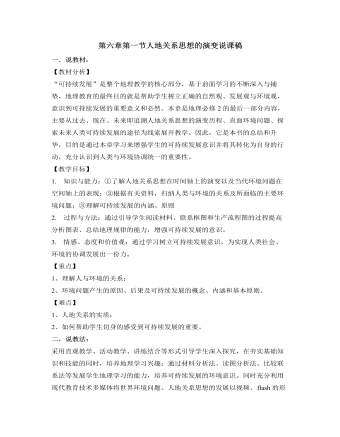
人教版高中地理必修2第六章第一节人地关系思想的演变说课稿
四、说教学过程:1、导入新课:以视频形式导入新课,说明环境问题产生原因,引出人地关系的重要性2、新课讲授:学习主题一:过去——人地关系的历史回顾以动画形式展现人地关系思想的发展,激发学生学习本专题的兴趣,归纳人与自然关系的演变过程。学习主题二:现状——直面环境问题以人类与环境关系模式图说明环境问题产生的原因,人地关系实质;以因果联系框图培养学生判读方法,了解人口、资源与环境三者之间的关系;通过阅读课文,了解环境问题的类型及其空间差异的表现;以图表了解不同国家和地区环境问题在空间轴上的表现;以《京都议定书》为引子说明保护环境是全人类的共同使命学习主题三:未来——可持续发展展示“可持续发展示意图”理解可持续发展内涵、原则

人教版高中地理必修2第一章第三节人口的合理容量说课稿
【教学目标】知识与技能:理解环境承载力与环境人口容量的含义、两者的关系以及环境人口容量的影响因素;理解人口合理容量的含义,影响因素并掌握保持人口合理容量的做法;结合中国国情提出适合中国保持合理人口容量的措施过程与方法:通过问题探究及案例分析理解环境承载力与环境人口容量的关系及影响因素;通过问题探讨掌握保持人口合理容量的措施。情感态度与价值观:树立并强化学生的可持续发展观念,科学发展观。激发学生爱国情感更多地关注国家国情,树立主人翁意识保护地球强大祖国。【教学重点】环境人口容量的内涵以及影响因素人口合理容量的影响因素以及措施【教学难点】环境人口容量的内涵以及影响因素人口合理容量的影响因素以及措施二、说教法【教学方法】案例分析、问题探究、归纳总结

